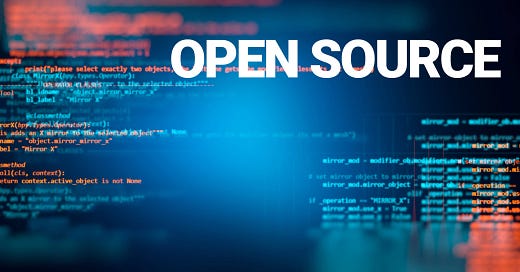Oniro App Store: Revolutionizing Open-Source Ecosystems
Oniro’s open-source ecosystem and strategic positioning could position it as a revolutionary force in the industry like the world wide web has done for industry since it's 1991 invention!
1. Open-Source Philosophy and Ecosystem Integration
Oniro App Store: Built on the OpenHarmony OS and backed by the Eclipse Foundation, Oniro emphasizes a fully open-source ecosystem. It supports cross-platform development (IoT, wearables, TVs, etc.) and integrates tools like React Native and Flutter, including Web 4.0 technologies such as WebGPU and Servo Rust-based web-rich apps, fostering interoperability and reducing fragmentation. This holistic approach allows developers to create apps for a unified ecosystem spanning multiple devices, breaking away from siloed platforms.
Why Oniro: Oniro’s alignment with OpenHarmony and cross-device compatibility offers developers a future-proof, scalable framework for full-end app development from the backend open source cloud database to the front end.
2. Zero Fees and Developer Flexibility
Oniro: Charges zero fees for OEM licensing, app publishing, or in-app purchases, allowing developers to retain 100% of revenue. Flexibility on 3rd party plugin revenue cuts e.g. RevenueCat and JusPay HyperSwitch with the PureHarmony framework and Open Mobile Hub integration.
Why Oniro is Better: The absence of fees and flexible monetization strategies make Oniro more attractive for developers, especially startups and indie creators.
3. Security and Compliance
Oniro: Prioritizes transparency through OpenChain compliance, ensuring apps adhere to free and open-source software (FOSS) licenses like GPL. Its security framework is designed to be auditable, reducing risks of malware or proprietary bloat.
Why Oniro: Oniro’s strict adherence to FOSS principles and IP compliance creates a more trustworthy environment for enterprises and privacy-conscious users.
4. Industry Disruption Potential
Challenging the Duopoly: Oniro’s open-source model directly challenges Apple and Google’s dominance by offering a DMA-compliant alternative in the EU. Its integration with Huawei’s HarmonyOS Next app development further expands its reach into China and emerging markets.
Revolutionary Potential: Oniro’s focus on interoperability (e.g., apps running seamlessly across IoT, mobile, and PCs) could redefine how developers build and users consume apps, fostering a decentralized, vendor-agnostic ecosystem.
5. Addressing Closed Proprietary Apps
Oniro: Encourages collaboration through community-driven development and FOSS compliance. Enterprises can contribute to the ecosystem while maintaining proprietary components, balancing openness with commercial needs.
Impact on Industry: Oniro’s model could pressure closed ecosystems to adopt more transparent practices, especially as regulatory scrutiny (e.g., EU’s DMA) grows.
Oniro App Store's open-source model has significant potential to address app and game preservation—a critical issue in digital ecosystems where proprietary stores often delist or abandon older software. Here’s how it tackles preservation challenges:
1. Decentralized Ownership & No "Gatekeeper" Removal
Unlike centralized stores (Google Play, Apple App Store), where apps can vanish due to policy changes or corporate decisions, Oniro’s open-source and community-driven model allows:
Forking and self-hosting: Developers or archivists can host their own instances of the store (similar to Aptoide’s model but with stricter FOSS compliance).
No arbitrary takedowns: Apps aren’t subject to a single entity’s whims, reducing the risk of sudden removals.
2. Source Code Availability for Longevity
Oniro encourages open-source app publishing, meaning:
If an app is abandoned, the community can maintain forks (e.g., like how FDroid preserves open-source Android apps).
Games built with open engines (Godot, Ren’Py) can be rebuilt/modified for future platforms, avoiding "bit rot."
3. Cross-Platform Compatibility via OpenHarmony
Oniro’s foundation in OpenHarmony ensures apps can adapt to new devices without dependency on a single OS (e.g., Android). This mitigates preservation risks tied to platform obsolescence (e.g., 32-bit app abandonment).
4. Regulatory & Legal Safeguards
Oniro’s OpenChain compliance ensures apps adhere to FOSS licenses (GPL, Apache), preventing proprietary lock-in that often leads to abandonware.
Contrast this with proprietary stores where:
Games/apps are lost due to licensing disputes (e.g., delisted Marvel games).
DRM servers shut down, rendering apps unusable (e.g., online-only mobile games).
Challenges & Limitations
Developer Adoption: Many commercial games/apps remain closed-source, limiting preservation to FOSS projects. However, Oniro App Store changes that app model!
Proprietary Dependencies: Apps relying on Google APIs or Apple frameworks may still face compatibility issues. OpenHarmony native APIs addesses these compatibility and interoperability issues with cross platform gaming developer framework tools.
Legal Gray Areas: While Oniro discourages piracy, abandoned proprietary apps could still face copyright hurdles if redistributed. Solution is partnerships with GitHub Archived read-only source code or other methods.
A Step Forward for Preservation
Oniro’s model actively supports preservation through its open infrastructure with an independent app platform framework technology stack inherited from OpenHarmony, but its impact depends on:
Developer buy-in (publishing open-source apps).
Community efforts (archiving, forking, and maintaining legacy software).
Industry shifts away from closed DRM and walled gardens.
If successful, it could set a precedent for true digital preservation in app ecosystems—something proprietary stores have consistently failed to deliver. For games, pairing Oniro with projects like Khronos Group’s open standards (Vulkan) could further future-proof compatibility.
Conclusion: A Catalyst for Change?
Oniro’s strengths—zero fees, zero licensing, cross-device integration, and FOSS compliance—position it as a viable alternative to other sole open source store distributions and proprietary giants. Oniro’s vision of an open, unified ecosystem aligns with global trends toward decentralization and regulatory reform. If adopted widely, it could spark an open-source revolution, reducing reliance on closed platforms and fostering innovation across industries. However, success depends on developer adoption and OEM partnerships, which Oniro is actively pursuing through OpenHarmony’s growing device base.




